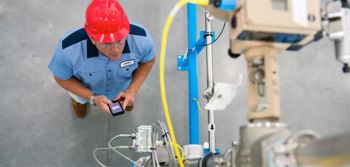When it Comes to Machine Assessments, it’s a Swing and a (Near) Miss (Part Five)
- March 25, 2021
- Best Practices
- Automation

There’s been a near miss on a machine. You’ve been tasked with looking into it, identifying problem areas, and fixing any issues.
Wow! This task can seem overwhelming. Where do you start? Well … that depends.
Safety standards tell you to start with a risk assessment, which is good advice. But, as we discussed in a recent blog about balancing ideal-world machine safety with real life, sometimes the real world pushes you to solve problems quickly without the necessary resources.
If your machine doesn’t have safety hardware, or if you’re designing a new machine, then you should follow the machine safety lifecycle we talked about about here; it always begins with a risk assessment.
If your machine does have safety hardware, and you’ve been tasked with solving this issue on your own, I recommend conducting a machine assessment by following these four steps.
Step #1: Count Safety Functions
Begin your assessment by counting the number of safety functions on the machine. From there, you can determine the Performance Level of each safety function. Then do a quick risk assessment on your own if you aren’t blessed with enough time and/or resources to conduct a team-based risk assessment.
But what counts as a safety function? A safety function is the entire safety circuit, which includes the input device, logic device, and output device. For example: A light curtain is an input device, a safety relay is a logic device, and a motor starter is an output device. Working together, these devices create a safety function. A Performance Level rates the entire safety function, not the individual components.
Here’s an example: Let’s say your machine has an E-stop, light curtain, and safety gate switch. The hazard movements include a motor powered by a motor starter and a robot. The E-stop, light curtain, and safety gate switch all stop the motor and robot when activated.
How many safety functions does this machine have?
- E-stop – safety relay – motor starter
- E-stop – safety relay – robot
- Light curtain – safety relay – motor starter
- Light curtain – safety relay – robot
- Gate switch – safety relay – motor starter
- Gate switch – safety relay – robot
There are a total of six safety functions that need to be analyzed to determine Performance Levels. Remember in this blog when we referenced using SISTEMA software to determine safety circuit Performance Level? You can also use SISTEMA software to evaluate safety functions.
Step #2: Analyze Device Mounting
Determine whether your devices are mounted correctly. Consider height, distance from the floor, and distance from the hazard.
ANSI B11.19-2019 is a great reference and includes look-up tables for reaching over, under, and through presence-sensing devices, as well as hard guarding. It also includes distance calculation formulas, which answer the question: Will the hazard be stopped before you can get to it?
Step #3: Evaluate Hard Guarding
Assess hard guarding using a guard safety scale, which is used for smaller openings in fencing or hard guards.
Also use the tables in ANSI B11.19-2019 to verify the maximum height and distance from the floor. Safe-distance calculations will be discussed in an upcoming blog.
Step #4: Required Performance Levels
Now that you know the Performance Level (PL) of your safety functions, you can return to your risk assessment and determine the Required Performance Level (PLr) of the hazards.
For example, let’s say you determine the risk level of the hazard produced by the robot in the example above to be high.
Based on the table below (found in ANSI/RIA TR R15.306), this means you have a PLr of d with a Category 3 structure. In other words: The safety functions that stop the robot—which would be #2, #4, and #6 in the list above—must be designed to meet PLd Category 3 requirements.
If SISTEMA results indicate that your safety circuit was anything less, then it needs to be addressed.
These four steps are a great start to assessing a machine. A thorough risk assessment will identify additional risks and problem areas that aren’t accounted for by following these steps.
Want to learn more about machine safety and safety standards? Start with these four blogs in our safety series:
- Balancing Ideal-World Machine Safety with Real Life (Part One)
- Where to Start with Machine Safety Standards (Part Two)
- Battle Royale: Performance Level vs. Safety Integrity Level (Part Three)
- Check Yourself Before You Wreck Yourself: How Much Risk Reduction is Enough? (Part Four)
As you move through this process, don’t hesitate to ask us questions. We have many TUV-certified machine safety engineers and technicians who are happy to help.
Stay tuned for more blogs in our safety series! Next up: We’ll take a close look at the details of a safety function.

ARTICLE BY:
RANDY TURNER For more information about Van Meter’s industrial controls solutions, please call 1-800-247-1410.
EMPLOYEE-OWNER, SOLUTION CONSULTANT - SAFETY